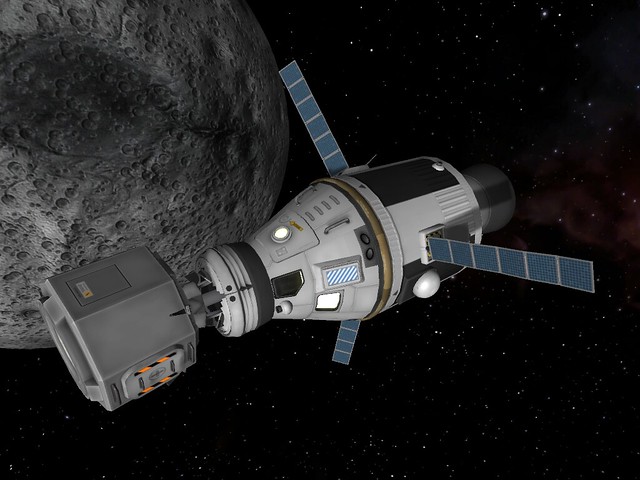The Wrong Way Round
Feb. 3rd, 2019 12:31 pmMission Designation : ND-11
Rocket Model : Nereid A-II
Mission Objectives : Recover Sigsted and his Module from Mun orbit
Total Mass (Mass to Orbit) : 96.5 tons (16.6 tons)
Total delta-V (dV to Orbit) : 6,225 m/s (2,639 m/s)
Surface TWR : 1.46
Part Count : 49
Contract for Construction : Year 4, Day 285
Nominal Build Time : 17 days
Total Cost : 54,491 funds
Launch Site : KSC
Launch Date/Time : Year 4, Day 303
Pilot : Kelhat Kerman
Engineer : Frando Kerman
The contract was to rescue Sigsted Kerm from Munar orbit and also to bring back the capsule he was in and everything was normal until the rescue craft entered the Mun’s sphere of influence and it was realized that they were going the wrong way.
Typically, craft in low Munar orbit are travelling west to east, like most craft in Kerbin orbit. Sigsted’s module, those, was traveling in a retrograde orbit, east to west and I had set up a rendezvous approaching head on.
The Nerid craft, designed for asteroid encounters, had a lot of surplus delta-V and could well have brought its relative speed with Sigsted’s craft to zero and still had plenty of delta-V to complete its mission of returning them all back to Kerbin. Instead, I decided to enter a highly elliptical orbit and then, when the craft reached apoapsis, reverse course. Moving slower at a high apoapsis means it takes less delta-V to reverse course than it would at the time of interception in a lower orbit.
After an extra day of fiddling about to change orbits, the rendezvous and capture was effected without further incident.

Mission Summary
Mission Elapsed Time : 4 days, 5 hours
Landing Site : Ocean 24 km east of KSC
Science : 6 points
Rocket Model : Nereid A-II
Mission Objectives : Recover Sigsted and his Module from Mun orbit
Total Mass (Mass to Orbit) : 96.5 tons (16.6 tons)
Total delta-V (dV to Orbit) : 6,225 m/s (2,639 m/s)
Surface TWR : 1.46
Part Count : 49
Contract for Construction : Year 4, Day 285
Nominal Build Time : 17 days
Total Cost : 54,491 funds
Launch Site : KSC
Launch Date/Time : Year 4, Day 303
Pilot : Kelhat Kerman
Engineer : Frando Kerman
The contract was to rescue Sigsted Kerm from Munar orbit and also to bring back the capsule he was in and everything was normal until the rescue craft entered the Mun’s sphere of influence and it was realized that they were going the wrong way.
Typically, craft in low Munar orbit are travelling west to east, like most craft in Kerbin orbit. Sigsted’s module, those, was traveling in a retrograde orbit, east to west and I had set up a rendezvous approaching head on.
The Nerid craft, designed for asteroid encounters, had a lot of surplus delta-V and could well have brought its relative speed with Sigsted’s craft to zero and still had plenty of delta-V to complete its mission of returning them all back to Kerbin. Instead, I decided to enter a highly elliptical orbit and then, when the craft reached apoapsis, reverse course. Moving slower at a high apoapsis means it takes less delta-V to reverse course than it would at the time of interception in a lower orbit.
After an extra day of fiddling about to change orbits, the rendezvous and capture was effected without further incident.

Mission Summary
Mission Elapsed Time : 4 days, 5 hours
Landing Site : Ocean 24 km east of KSC
Science : 6 points











 If you look at the path you build for a typical KSP transfer, watch what happens as you go from an SOI encounter to a closer Mun periapsis. The path after passing the Mun tracks out a larger and larger orbit and eventually escapes Kerbin's SOI altogether. If something went wrong with the engine when you wanted to enter the Mun's orbit, the craft might instead be flung out into deepy space.
If you look at the path you build for a typical KSP transfer, watch what happens as you go from an SOI encounter to a closer Mun periapsis. The path after passing the Mun tracks out a larger and larger orbit and eventually escapes Kerbin's SOI altogether. If something went wrong with the engine when you wanted to enter the Mun's orbit, the craft might instead be flung out into deepy space.



 Mission Designation : YT-2
Mission Designation : YT-2

 Or, do what I do and get the
Or, do what I do and get the 






